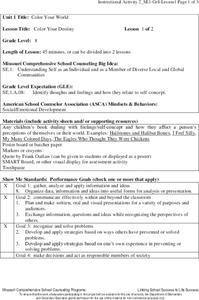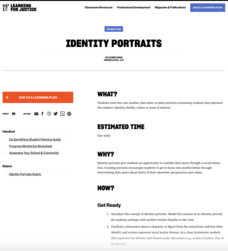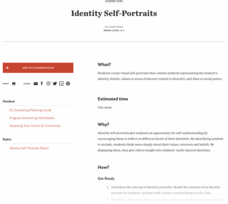Facing History and Ourselves
Identity and Labels
Scholars look at the connections between identity and labels, assumptions, and stereotypes, in a lesson plan that examines identity in the United States. To set the stage for a discussion of these connections, class members analyze a...
Facing History and Ourselves
Identity and Names
Would a rose smell as sweet, as Juliet Capulet asserts, if called by any other name? The importance of names and the connection between names and identity are examined in a lesson that explores identity in the United States. After...
Facing History and Ourselves
Finding Your Voice
To begin a study of what it means to be American, high schoolers first consider their own identities. They draw a picture of what they think an American looks like and share their images. Next, they examine an image of the "Flag of...
Health Smart Virginia
Self Image
A 14-slide presentation walks a class through a lesson on self-image. While responding to scenarios and answering questions thoughtfully, scholars use pictures to complete a worksheet that offers describing words, emphasizes their inner...
California Department of Education
Learning About Myself
After completing an interest survey, peers group together based on similar likes. They work collaboratively to create a poster that highlights their interests. Groups share their finished products with the class.
Health Smart Virginia
Positive Self-Image Performance Task
Encourage positive self-image with a hands-on activity. Scholars create a themed collage comprised of pictures, personal traits, compliments, and unique styling to show off the creator's personality.
Health Smart Virginia
Mental and Emotional Health
Working in groups, sixth-graders identify internal factors that negatively impact them. Then, explain how they could change that factor into a positive influence. Finally, individuals create personal mind maps that identify their...
Health Smart Virginia
Compliment a Character
Compliments are true, specific, and positive. Crafting those compliments can be a challenge. Graciously accepting a compliment can also be a challenge. The first lesson in the Health Smart series designed for sixth graders provides them...
Health Smart Virginia
Social Emotional Skills Lessons Overview
The Unit 1 - Overview of the Health Smart Grade 6 series provides instructors with the rationale and goals of a five-resource unit designed to support scholars' social and emotional development. Packed with activity ideas, the resource...
Health Smart Virginia
Mental Health PowerPoint and Notes
A 15-slide presentation summarizes key concepts from the Mental Health unit designed for freshmen. Viewers record the information on the provided worksheets. The notes prepare learners for a game of jeopardy.
Health Smart Virginia
What Is It Like to Be You?
Two poems, "What it is like to be you" and "I am more than what you see," provided young scholars an opportunity to reflect on how others see them versus how they see themselves. After reading the poems, individuals write their stories...
Health Smart Virginia
Building Self-Esteem and Self-Image
The ninth lesson in the Health Smart series is designed to get high schoolers to understand the factors that make them feel the way they do about themselves, their bodies, and their self-worth. Pupils watch a video about teens and body...
Department of Education (Ireland)
Decision Making
Think it through! That's the big takeaway from a series of lessons about decision-making. Young scholars engage in a series of exercises and activities designed to urge them to look at options, the pros, and cons of a course of action,...
Idaho Coalition
The Hunger Games: Gender Empowerment
The odds are in your favor that your pupils will love this lesson plan that uses The Hunger Games to launch a study of gender empowerment, as well as the influence of social constructs of gender. Groups discuss how Katniss Everdeen and...
Facing History and Ourselves
The Costs and Benefits of Belonging
Peer pressure and the desire for acceptance are powerful things. A thought-provoking lesson looks at the positive and negative effects of wanting to belong to a group. Class members examine the roles of the perpetrator, the victim, the...
Missouri Department of Elementary
Color Your Destiny
Class groups bring feeling words alive by creating a poster that illustrates with images and colors, but not words, the feeling conjured by the word. The posters are then combined into a mural for the classroom wall.
Missouri Department of Elementary
What Is Important to Me?
Pupils complete an activity sheet to determine what values are most important to them. They then discuss their responses with partners before sharing the results of the discussion with the class.
Equality and Human Rights Commission
Learning area 1: Who am I?
Five activities encourage scholars to dream big and celebrate the similarities and differences of those around them. Learners take part in two active practices that showcase how their peers are the same and different. Worksheets...
Equality and Human Rights Commission
Learning area 2: Challenging Stereotypes and Discrimination
Six powerful and eyeopening lessons provide scholars with activities designed to challenge stereotypes and discrimination. The unit provides reading material with which pupils read and discuss. Grand conversations lead to physically...
Nemours KidsHealth
Self-Esteem: Grades 3-5
Two lessons examine self-esteem and encourage scholars to exude confidence. Lesson one asks learners to recognize the characteristics of self-esteem then create a collage compiled of images that reflect their skills, accomplishments, and...
Teaching Tolerance
Using Photographs to Teach Social Justice | Exploring Identity
Even without captions, photographs can tell amazing, involved, and complex stories. Viewers analyze two photos, consider what the pictures reveal about the subjects' identity, and determine the social justice issues represented in the...
Thoughtful Learning
Learning to Say No
It's not always easy to say "no". Give scholars the power and confidence to stand up for themselves with several steps to communicate using their voice and body language.
Teaching Tolerance
Identity Portraits
When you look at me, what do you see? Young learners answer this question by creating a portrait that reflects the identity of one of their peers. First, class members create interview questions. Then, they interview classmates to...
Teaching Tolerance
Identity Self-Portraits
What symbols represent you best? Individuals consider how they would draw peers using symbols about their identities with an interview and art activity. After conducting interviews and portraits, the art makes a great centerpiece for...

























